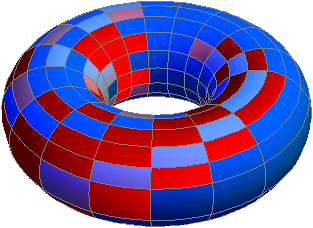IntMath Newsletter - Math in emails, vector fields, hard fun
By Murray Bourne, 16 Sep 2009
In this Newsletter:
1. Math tip (a) – How to send an email containing math
2. Math tip (b) – Vector fields
3. Math tip (c) – Hard fun
4. From the Math Blog
5. Final thought – Reading the universe
1. Math tip (a) – How to send an email containing math
I've been working on a system to make it easier to send emails containing math.
In most mail systems, the best you can do is to add subscripts and superscripts, but it is not possible to type summation, square root and integral signs, or fractions.
Go check out the Math Mail System:
2. Math tip (b) – Vector fields
I wrote a special article on Vector Fields for this Newsletter. A vector field is like a map that indicates the size and direction of vectors for different positions in space. There are many interesting applications in the real world.
I found most of the vector field definitions in textbooks were very formal and they didn't help a newbie's understanding. I hope this is easier to understand.

A vector field mapped on a torus (donut)
Go to: Vector fields - a simple and painless introduction
3. Math tip (c) – Hard fun
What activity are you passionate about? Is it a sport, reading, making things, or perhaps computer games?
If you have a passion for something, it means you are willing to voluntarily put in lots of effort to achieve some desired outcome. And in the process, you learn a lot of things. This is authentic learning, and it is the result of hard fun.
Seymour Papert used the phrase "hard fun" to describe learning that is based on activities that...
... will harness the passion of the learner to the hard work needed to master difficult material and acquire habits of self-discipline.
Like most skills, math does not come automatically to most people. The only way we achieve in math is to devote some time having "hard fun". The "fun" comes from the "aha" moments that are inevitable after we struggle with some new problem. It may be "hard" at times, but it is certainly worth it.
You can read a short article by Papert (who studied under the famous psychologist Jean Piaget) on the topic here: Hard Fun
4. From the Math Blog
a) How to write math in an email
Writing emails that contain math is usually a problem - how do you enter all those signs and symbols?
b) Vector fields - a simple and painless introduction
Vector fields give us a way to map vectors that vary in a space.
c) Friday math movie - The Maggie Sort Algorithm
This cute film demonstrates problem-solving, algorithmic thinking and persistence. Maggie's having "hard fun" - but she doesn't know it yet!
d) Enter math in emails, forums and Web pages using ASCIIMathML
Frustrated trying to communicate math in emails or in a blog? ASCIIMathML may be your solution.
5. Final thought – Reading the universe
Here's something from the Italian astronomer Galileo, who risked death by supporting the view that the sun is the center of the solar system.
The Universe is a grand book which cannot be read until one first learns to comprehend the language and become familiar with the characters in which it is composed. It is written in the language of mathematics.
– Galileo
Until next time, all the best and have hard fun.
See the 6 Comments below.
17 Sep 2009 at 2:50 pm [Comment permalink]
I have already written here, but to add this: was a top letter with vectors and maths in emails. Now do a tensor one. Just shows the truth is out there.
18 Sep 2009 at 3:33 am [Comment permalink]
Your post reminded me of my alternative to writing Maths and that is to use some sort of screencast tool. I love screenr - really quick and easy.
18 Sep 2009 at 5:54 am [Comment permalink]
i need more info on calculus thank u
18 Sep 2009 at 4:38 pm [Comment permalink]
Greetings to you Mr.Murray, i should say am priveledged to have subscribed to your monthly articles, they have enhanced my career as a math instructor, can you imagine i can now write math in a mail comfortably! The idea of hard fun is fun indeed! iam looking forward for the next math article.
19 Sep 2009 at 5:24 am [Comment permalink]
Out:"The pleasure of Finding things out". Richard P. Feynman. Page 15. Quote:" If you are interested in the ultimate character of the Physical world, or the complete world, and at the present time our only way to understand that is through a mathimatical type of reasoning,then I don't think a person can fully appreciate ....these particular aspects of the world....without an understanding of mathematics."
19 Sep 2009 at 8:04 am [Comment permalink]
Thanks, Colleen! I like the look of screenr and I'll investigate it further.